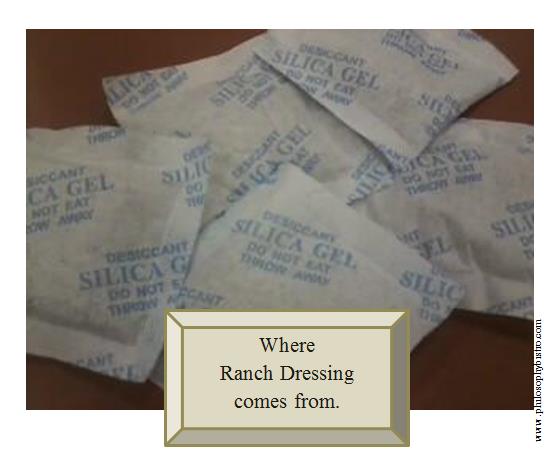Category Archives: Uncategorized
From the Hidden Valley
Image
Closed for Construction
Due to an electrical fire, we are closing Robert’s Philosophy Bistro while we do some repairs. Nobody was hurt in the fire.
Dr Bear
Tonight’s Entree delayed
Due to bad weather, illness in the family, and an inexplicable employee absence, tonight’s Bistro column will be delayed.
Concerning James:
Just a note for those of you who follow the Bistro:
My brother James, whom I mentioned in a previous post,
is having heart surgery early Tuesday morning.
Although he’s in fairly good health (for a sedentary 52-year-old), his heart has not been pumping well, and he will be having a valve in his aorta replaced.
Cards can be sent to my parents’ address.
I’ll try to keep you posted.
hitting the road
from Aristotle’s Politics
Improvised Oatmeal
It recently occurred to me how odd my recipe collection here in my posts is. From reading here, one would get the impression that I cook mostly muffins; that is not the case. The recipes that I post are for things that I actually bother to follow a recipe for; most of the things I cook–the stews, pastas, potatoes & rice dishes that make up my day-to-day life aren’t necessarily planned, and certainly aren’t measured–and this is what most cooking, as well as most of my life, is like: I look at what’s available, and I make the best of it.
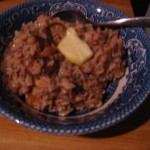 Among the best is this breakfast oatmeal, which my daughter and I started making after having some incredible oatmeal at the Tiny Cup Café in Brooklyn. The inspiration was theirs, but the genius behind it is probably my daughter’s.
Among the best is this breakfast oatmeal, which my daughter and I started making after having some incredible oatmeal at the Tiny Cup Café in Brooklyn. The inspiration was theirs, but the genius behind it is probably my daughter’s.
Ingredients:
- Oatmeal
- Milk or something like it (I use some unsweetened almond milk and a little sweetened)
- Salt
- Nuts
- Dried Fruit
- Fresh Fruit
- Pumpkin Seeds
- Sunflower Seeds
- Coconut
- Chocolate Chips
- Peanut Butter
- Whatever else you can think of
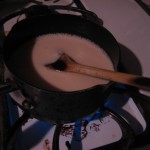
Step 1, Heat the liquid: It doesn’t matter how much, but I would advise about a cup per serving, I like to get it boiling first, then add a dash of cinnamon and salt, but you can do what you have to.
Step 2, Add the dry ingredients and stir, let simmer: Half 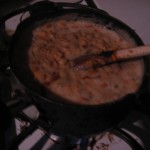 the amount of oatmeal that you added of liquid. If you are adding dried fruit (or fresh), I like to add it next so it softens, but you might like it firmer. At this point, I am digging through my nut drawers and seeing what there is to add. I love dried cherries, almonds, sunflower and pumpkin seeds, but I make do with what is in the drawer.
the amount of oatmeal that you added of liquid. If you are adding dried fruit (or fresh), I like to add it next so it softens, but you might like it firmer. At this point, I am digging through my nut drawers and seeing what there is to add. I love dried cherries, almonds, sunflower and pumpkin seeds, but I make do with what is in the drawer.
Step 3, Simmer: Until it gets firm and lumpy, maybe 20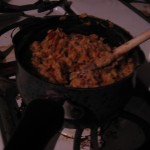 minutes; usually, I am ironing a shirt at this pint, so I don’t really know how long it takes.
minutes; usually, I am ironing a shirt at this pint, so I don’t really know how long it takes.
Step 4, Serve: I like a pat of butter on it, and maybe some brown sugar, but some people like a little more milk or cream.
Audio Post
As most weeks, an audio version of tonight’s entree is available here.
A Hard Place to Do Anything but Be
K and I went on a hike on Saturday. (For clarity’s sake I should say that K is my wife and “K” is her initial. She is not to be confused with the protagonist of Kafka’s The Castle. “I” meanwhile, is a pronoun and not an initial. I = I, and also me. But I digress.) Our home, Issaquah, Washington, is decidedly suburban, but with the uncommon advantage of abutting the Cascade mountains. Every exit along I-90 offers numerous gorgeous hikes in both directions, none – at least that I’ve yet encountered – more stunning than the one leading to Melakwa Lake.
Melakwa Lake
You get there by taking exit 47, which offers the opposite of a Hobson’s choice. If you turn right you’re on your way toward Annette Lake, itself a delightful destination whose course passes by McClellan Butte, which I think must be named for Union General George B. McClellan. In the 1850s the first governor of Washington Territory, Isaac Stevens, arranged for a survey of a potential transcontinental railroad route from St. Paul, Minnesota to the Puget Sound. Stevens and his party scouted west from their starting point along the Mississippi River while McClellan led a company around both sides of the Cascades, seeking the best way through north of the Columbia River. Since Ken Burns’ PBS special on The Civil War, it’s been all too easy to treat McClellan as a joke, though he probably deserves better. His stellar career in the pre-war military as an engineer led him to a vice-presidency of the Illinois Central Railroad, and his disappointing but by no means disastrous tenure as commander of the Army of the Potomac set McClellan up as the Democratic candidate for President in 1864, when he won a respectable 45% on the vote in the loyal Union states. He shouldn’t be a ridiculous figure. And yet, if you read the account of McClellan’s half-hearted and decidedly incomplete efforts to discover the best pass through the Cascades, including his patented whining and suspicion about his superior’s competence and motives, it’s hard not to laugh at least a little at this brittle and prickly man. Though he did divine the pass – Snoqualmie – that would ultimately offer the most direct route to the Puget Sound, he didn’t actually complete the trek across it and thus confirm that there was a reasonable way through. I’ve never been able to determine for certain that McClellan Butte is actually named for George, but it would be a tremendous coincidence if it weren’t. I like to think that it marks the point of his maximum progress from the west, only five miles or so from the summit. That’s the McClellanite condition in a nutshell: close, but not close enough.
But don’t go that way. Turn left instead and drive to the trail head that will take you rather spectacularly under a high and lengthy I-90 overpass

If I ever make a Pacific Northwest version of Mad Max, I’m setting a scene here.
until you reach the Denny Creek waterfalls, a rocky playground that serves as the setting for one of the sadder scenes in Garth Stein’s The Art of Racing in the Rain. One weird facet of living in the Seattle area is that not only are there so many published authors here, but a striking number of their books take place in the greater Seattle area. It gets difficult to go anywhere without thinking of a pertinent passage. The stage is thus set for the meta-novel in which many of these fictional characters meet in a unified narrative Seattle and fight it out. But the dozens of kids and adults playing around these waterfalls don’t for the most part know anything about all that. They’re just playing in the water in the woods, the way people in the Pacific Northwest do.
Don’t stop there. Another mile or so up the trail the pines and firs part, revealing a much grander waterfall across a chasm. Don’t stop there either. Carry on up the steeper trail through a hemlock woods to the top of the pass, then descend a steady half mile to a crystal clear green lake cradled by a series of rocky crags. The first time I visited Melawka Lake I wondered how Native Americans had made use of such a beautiful area before European settlers arrived. From my reading since, including Coll Thrush’s Native Seattle, I’ve come to appreciate what should have been obvious, namely that the tribes stayed close to the plentiful food offered by the sound and its tributary rivers. Alpine lakes like Melawka, though beautiful, wouldn’t have provided enough sustenance for lengthy settlement, particularly in the winter. Still, the people living in the area wouldn’t have missed this spot. Surely they hiked miles out of their way sometimes just to experience it. The newest non-invasive archaeological techniques may reveal some interesting finds someday. Or maybe the lake’s visitors will continue being too busy experiencing it to study it. It’s a hard place to do anything but be.
And that’s the news from Lake Melakwa. This is the Philosophy Bistro, so I usually try to draw some sort of lesson. Not this time. The lack of lesson is the lesson. It’s Labor Day weekend, which we usually celebrate by trying not to labor. K and I climbed up from Denny Creek to sit together on the bank of a mountain lake. We didn’t have a reason and didn’t want one. I hope your weekend was as lovely as ours.
Photo credits: monkeypuzzleblog.com, tmber.com


